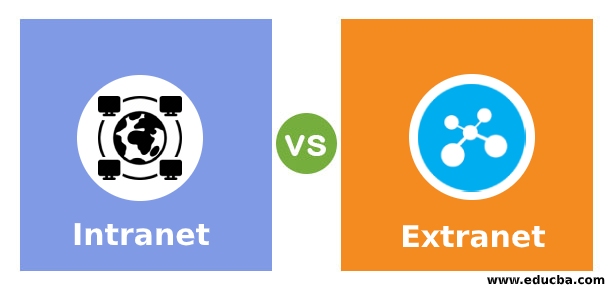
Difference Between Intranet vs Extranet
The following article provides an outline for Intranet vs Extranet. A computer network system called the extranet is defined as a private network that organizations, institutions, or groups can utilize to share sensitive information, knowledge, and perform various operations. Access is restricted to authorized users only. The intranet is also a type of computer network system that is private and is accessible to a particular group of the organization in a specific place so that information and knowledge can be shared among the group using the network.
Head to Head Comparison Between Intranet vs Extranet (Infographics)
Below are the top 9 differences between Intranet vs Extranet:
Key Difference Between Intranet vs Extranet
Let us discuss some of the major key differences between Intranet and Extranet:
- One of the major differences between extranet and intranet is the number of users that can access the network. The intranet users’ net, in particular, as the intranet network can only be accessible to a specific group of organizations. The extranet network allows access to more users since it enables information sharing among a specific group of organizations, external members of an organization, stakeholders, and clients.
- The other difference between both types of networks is the network’s security. The intranet network can have a defined firewall that can protect the web from accessing the intranet network. In the extranet network,rk the firewall must help segregate the external members and organization members so that the organization can easily access them.
- The organization’s HR and CIO manage an intranet network so valid users can access the network. The communication department of the organization manages the network of extradition.
- Only a specific group or organization can access certain information in an intranet network. In the extranet network, the sharing of information between the organization and external members creates a risk of unauthorized access to the organization’s sensitive data. The organization decides the policies and access so only valid users can access the network, including the extranet and intranet. As the intranet network uses a limited interface, it provides better security to users of the intranet network. Providing security to the extranet users is more complex than the intranet network as in an extranet network, the external users are also there, which creates a risk of a security breach.
- The other difference between extranet and intranet networks is the utilization of resources. The intranet network users can utilize the resources in a better way compared to the extranet network. Whereas in the intranet network, the data is sufficient for the network users to execute business operations for the organization easily.
- The other difference between an intranet network and an extranet network is the accessibility of the network. The intranet network can only access by a single group or an organization.
- The other difference between the intranet network and extranet network is implementing network company servers, and the system can implement the intranet network.
Intranet vs Extranet Comparison Table
Let’s discuss the top comparison between Intranet and Extranet:
| Factor | Intranet | Extranet |
| Description | The intranet is a private network that provides access to a specific group of users, allowing them to share information and knowledge within the network. | The extranet is a private network that utilizes the public network to share knowledge and information with stakeholders and clients of the organization. |
| Network size | Intranet network size is small, as in this type of network; only a few users are connected to each other. | The extranet size of the network is also very small, as only a few users are connected to each other. |
| Purpose | The main purpose of using the intranet network is to share confidential and sensitive information within the organization. | The extranet network is used for sharing information between the organization and external members that, includes clients and stakeholders. |
| Content on network | The content and information present on the network can only be accessible by some users and organization members. | The content and information present on the extranet network can be accessible by the organization members and external organization members, like clients and stakeholders. |
| Regulation and mechanism | The intranet network can be controlled only by one organization. The policies of the organization govern the intranet network. The extranet network, on the other hand, can be governed by multiple organizations. | ns. Contractual agreements are used to regulate the extranet network. |
| Ownership of network | A single organization owns and manages the intranet network. | One or more organizations maintain ownership of the extranet network. |
| Access | the internet can easily access the intranet network; the only requirement is a password, as only valid users can access the network. | The extranet network can also access using the internet. |
| Security | A firewall mechanism is used to provide security to the intranet network. | The firewall mechanism separates the extranet and the internet in the extranet network. |
| Information | The intranet network contains information about some particular group only. | The extranet network also contains information on specific organization groups. |
Conclusion
For any organization, the security of information is always the main concern. So, the organization should implement an intranet network to share information among the organization members.
Recommended Articles
We hope that this EDUCBA information on “Intranet vs Extranet” was beneficial to you. You can view EDUCBA’s recommended articles for more information.

